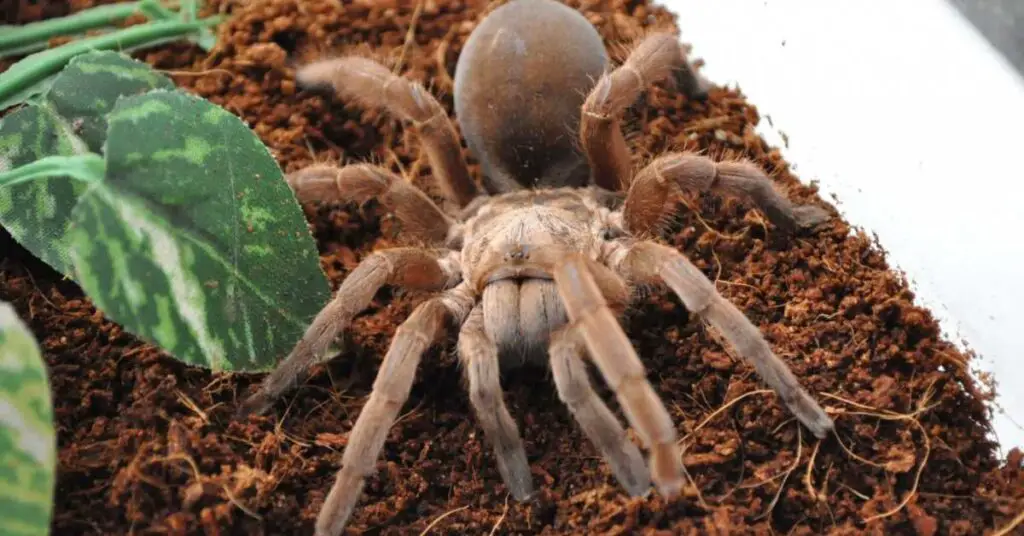Are you perplexed by your pet tarantula’s lack of appetite? It’s quite disconcerting, isn’t it?
Well, fear not, for there could be several reasons as to why your eight-legged friend is refusing to dine. From the stress of its environment to potential health issues, there are numerous factors that may be hindering its eating habits.
So, if you’re eager to discover the secrets behind your tarantula’s appetite, buckle up and prepare to uncover the mysteries that lie within the world of these fascinating creatures.
Key Takeaways
- Stress can significantly impact a tarantula’s appetite, including stress-induced anorexia and the effects of environmental changes and handling.
- Proper care and environment are crucial in maintaining a healthy appetite for tarantulas, including minimizing stressors, consulting a veterinarian, and providing a stress-free environment with appropriate temperature, humidity, and hiding spots.
- Understanding the appropriate prey size and feeding techniques for tarantula species is essential to prevent negative impacts such as overfeeding or underfeeding.
- Establishing a proper feeding schedule and using appropriate methods, such as providing live prey for natural hunting and capture, can help stimulate a tarantula’s appetite and maintain their natural feeding patterns.
Stress as a Common Appetite Suppressant
Stress is a frequently encountered and well-documented appetite suppressant in tarantulas. Tarantulas, like many other animals, can experience stress-induced anorexia, resulting in a reduction or complete loss of appetite. This phenomenon is commonly observed in captive tarantulas, particularly when they’re exposed to environmental changes or handling.
Stress-induced anorexia in tarantulas can have significant consequences, leading to nutritional deficiencies and overall poor health. When tarantulas don’t eat, they’re unable to obtain the necessary nutrients for growth, reproduction, and maintenance of bodily functions. This can result in weakened immune systems, decreased energy levels, and even death if left untreated.
In order to address stress-induced anorexia in tarantulas, it’s crucial to identify and minimize potential stressors in their environment. This includes providing them with appropriate temperatures, humidity levels, and hiding spots to create a sense of security. Additionally, minimizing handling and disturbances can help alleviate stress and encourage feeding.
If a tarantula continues to exhibit anorexia despite reducing stressors, it may be necessary to seek veterinary intervention. A veterinarian specializing in exotic animals can provide a comprehensive evaluation to rule out any underlying health issues that may be contributing to the loss of appetite. Nutritional deficiencies can be addressed through supplementation and a well-balanced diet tailored to the specific needs of the tarantula species.
Understanding the impact of stress on tarantula feeding behavior is crucial for their overall well-being. By minimizing stressors and providing appropriate care, tarantula owners can help ensure that their pets maintain a healthy appetite and receive the necessary nutrients for optimal health.

Illness or Underlying Health Issues Affecting Appetite
When tarantulas exhibit anorexia despite the reduction of stressors, it’s important to consider the possibility of illness or underlying health issues affecting their appetite. Tarantulas are generally hardy creatures, but they can still fall victim to various illnesses that can impact their feeding behavior. One of the most common health issues that can lead to appetite loss in tarantulas is malnutrition. Tarantulas require a balanced and varied diet to meet their nutritional needs, and a lack of proper nutrition can weaken their immune system and overall health, leading to a decreased appetite.
In addition to malnutrition risks, environmental factors can also play a role in affecting a tarantula’s appetite. Temperature and humidity levels that are outside of their ideal range can cause physiological stress, which can impact their feeding behavior. It’s crucial to ensure that the tarantula’s enclosure is properly set up with appropriate temperature and humidity levels, as well as providing a suitable hiding spot for them to feel secure.
If your tarantula continues to exhibit a loss of appetite despite addressing potential stressors and environmental factors, it may be necessary to consult a veterinarian who specializes in exotic pets to rule out any underlying health issues and provide appropriate treatment.
Molting Process and Its Impact on Feeding Behavior
The molting process in tarantulas significantly impacts their feeding behavior and can result in temporary loss of appetite. Understanding how the molting process affects feeding behavior is crucial for tarantula owners. Here are three key aspects to consider:
- Growth stages:
Tarantulas go through several growth stages throughout their lives. During the molting process, they shed their old exoskeleton and emerge with a larger one. This growth stage requires a lot of energy and resources, diverting their focus away from feeding. - Hormonal changes:
Hormonal changes occur during the molting process, affecting the tarantula’s appetite. These changes can lead to a decrease in feeding behavior as the tarantula’s body focuses on preparing for molting rather than consuming food. - Post-molt recovery:
After molting, tarantulas need time to recover and harden their new exoskeleton. During this period, they may still be reluctant to eat due to their vulnerable state. It’s essential to provide a stress-free environment and offer small, easily digestible prey to encourage feeding.
Understanding the molting process and its impact on feeding behavior can help tarantula owners provide the necessary care and support during this crucial time. Remember to be patient and allow your tarantula the time it needs to recover and resume its normal feeding routine.
Inadequate Enclosure Conditions Hindering Eating Habits
Improper enclosure conditions can negatively impact the eating habits of tarantulas, leading to decreased appetite and potential health issues. Tarantulas are ectothermic creatures, meaning they rely on their environment to regulate their body temperature. If the temperature in their enclosure is too low or too high, it can disrupt their metabolic processes, including their appetite. Tarantulas thrive in temperatures ranging from 70 to 85 degrees Fahrenheit, and deviations from this range can cause them to lose interest in food.
Another important aspect of tarantula enclosures is the presence of hiding spots. Tarantulas are secretive creatures by nature and need a safe space to retreat to. If their enclosure lacks adequate hiding spots, they may feel exposed and vulnerable, which can lead to stress and a loss of appetite. Providing multiple hiding spots, such as cork bark, fake plants, or small caves, can help create a sense of security for your tarantula.
In addition to temperature and hiding spots, it’s crucial to maintain proper humidity levels in the tarantula enclosure. Tarantulas come from diverse habitats, and their specific humidity requirements vary depending on the species. Some tarantulas prefer a drier environment, while others require higher humidity levels. Failure to provide the appropriate humidity can result in dehydration or respiratory problems, both of which can affect their appetite.
To ensure your tarantula’s eating habits remain healthy, it’s essential to create an enclosure that mimics their natural habitat as closely as possible. Paying attention to temperature, providing adequate hiding spots, and maintaining proper humidity levels will help create an environment in which your tarantula feels secure and comfortable, ultimately promoting their appetite and overall well-being.
Incorrect Feeding Techniques Leading to Refusal of Food
A crucial aspect of proper tarantula care involves employing correct feeding techniques to prevent the refusal of food. Tarantulas are known for their voracious appetite, but there are instances when they may refuse to eat, and this can be attributed to incorrect feeding techniques. To ensure your tarantula’s well-being and satisfaction, it’s essential to avoid the following mistakes:
- Improper Prey Size: Tarantulas have specific prey size preferences, and offering prey that’s too large or too small can lead to refusal of food. It’s important to research and understand the appropriate prey size for your particular species of tarantula.
- Incorrect Feeding Schedule: Tarantulas have different feeding schedules depending on their age and species. Feeding them too frequently or infrequently may result in a lack of interest in food. It’s crucial to establish a proper feeding schedule and adhere to it consistently.
- Inadequate Feeding Method: Tarantulas are ambush predators and prefer live prey. Using inappropriate feeding methods such as tong feeding or force-feeding can cause stress and result in food refusal. It’s best to provide live prey and allow the tarantula to hunt and capture its food naturally.
Potential Behavioral Factors Influencing Appetite in Tarantulas
Potential factors influencing the appetite of tarantulas include their natural instincts, environmental conditions, and previous feeding experiences.
Tarantulas are highly adaptable creatures, and changes in their environment can have a significant impact on their appetite. Environmental changes such as temperature, humidity, and lighting can affect the metabolism and digestion of tarantulas, which in turn may alter their feeding behavior.
For example, a decrease in temperature may slow down their metabolism, leading to a decreased appetite. Additionally, seasonal variations can also influence the feeding patterns of tarantulas. In the wild, some tarantula species may exhibit reduced feeding activity during certain times of the year, such as the breeding season. This could be due to hormonal changes or a natural response to environmental cues.
Understanding the natural feeding patterns of tarantulas can help tarantula owners provide appropriate conditions and adjust their expectations accordingly. It’s important to note that individual tarantulas may also have their own unique feeding preferences and quirks, which can be influenced by their previous feeding experiences.
Frequently Asked Questions
How Long Does the Molting Process Typically Last for a Tarantula?
The molting process for a tarantula typically lasts for a few weeks. Factors such as temperature and humidity play a role in the duration. It is important to provide a suitable environment to ensure a successful molt.
What Are Some Signs of Stress in a Tarantula?
Signs of stress in your tarantula include refusing food, excessive grooming, hiding, and aggressive behavior. To reduce stress, provide a suitable habitat, avoid sudden changes, maintain proper temperature and humidity levels, and handle with care.
Can Tarantulas Get Sick From Not Eating?
Tarantulas can indeed get sick from not eating. Their feeding habits are crucial to their well-being and overall health. It is important to monitor their eating habits closely to ensure their tarantula health concerns are addressed promptly.
How Often Should I Feed My Tarantula?
To ensure your tarantula’s well-being, it’s important to establish a proper feeding schedule. Consider the species and age of your tarantula when determining how much to feed. Regular meals will help maintain its health and vitality.
Are There Any Specific Feeding Techniques That Tarantulas Prefer?
When it comes to feeding habits, tarantulas have specific preferences. They thrive on live prey, such as crickets and mealworms. Offering a varied diet is key to maintaining their health and ensuring they eat.
Conclusion
In conclusion, there are several possible reasons why a tarantula may not be eating.
Stress, illness, molting, inadequate enclosure conditions, and incorrect feeding techniques can all contribute to a loss of appetite in these fascinating arachnids.
It’s important for tarantula owners to carefully assess these factors and make appropriate adjustments to ensure the well-being and feeding habits of their pet tarantulas.
By addressing these potential issues, tarantula owners can help ensure a healthy and thriving spider.


